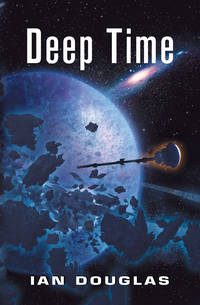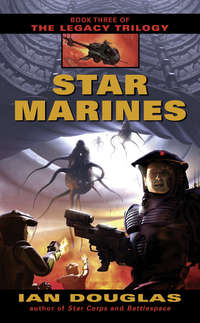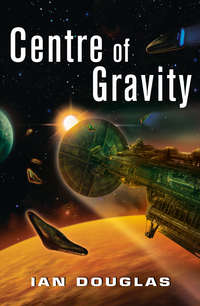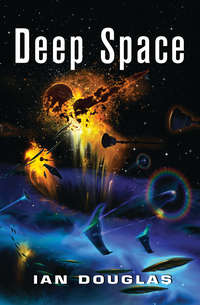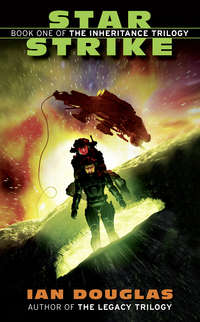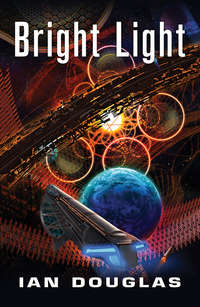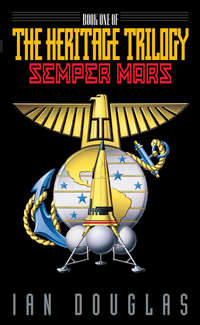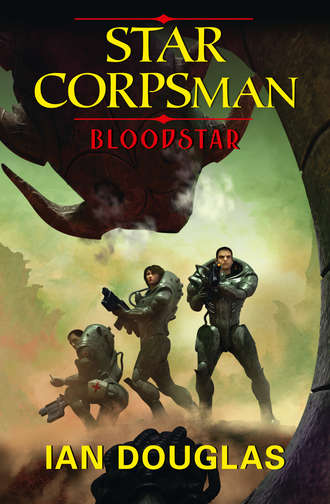
Полная версия
Bloodstar
There were three of them, polished silver reflecting the bloody light, essentially flattened disks with a central bulge and a bite taken out of the trailing edge. The sides curved downward, like small wings or auxiliary stabilizers. I could only guess at the size, but they looked big for atmospheric vessels—maybe 100 meters or more across. They were using plasma thrusters to lower themselves gently toward the ground, as clouds of tiny glittering craft spilled from vents or ports along their undersides; I could see the swirling clouds of dust being raised by their jet wash as they settled down one after another on the spaceport in the distance. Human figures were running in confusion among the buildings, looking slow and clumsy in heavy environmental suits. The buildings of the colony began exploding one after another, with sharp flashes and fast-expanding pressure waves clearly defined by the thick, wet air. Each blast geysered a cloud of smoke and debris hurtling into the red sky, clouds that then tattered away with the wind.
The camera jerked and spun; the landscape blurred for an instant with the movement. In another direction, more of the disk vessels were settling to the ground.
An armored figure appeared: gleaming overlapping segments covering a body several meters long. It might have been as big as an extinct Terran rhinoceros, but with a longer body and six legs. The upper body, like the forequarters of the mythical centaur, weaved back and forth, displaying a single centrally positioned arm. The grippers at the end were holding a weapon of some sort.
What sort we couldn’t tell. An instant after seeing it, the scene dissolved into white static.
“The earlier reports,” Captain Carter said, “have been confirmed with this transmission.”
The static gave way to a VR simulation of the colony, fully interactive, the city domes and towers gleaming undamaged beneath the red sun.
“The armored figure you just saw was a Qesh warrior,” Carter went on, “and the ships appear identical to the vessels designated as ‘Rocs’ encountered during our first contact with that species fifty-nine years ago. Clearly, the Qesh have entered the Gliese 581 system and landed a raiding party, at the very least … and possibly they have arrived with a full invasion force.
“Commonwealth Military Command is taking this very seriously. Our first contact with Qesh raiders took place at a star system ninety-four light years from Earth. Gliese 581, however, is just twenty light years from Sol, a near neighbor as interstellar distances go. Only eighty-eight other stars are closer. CMC is concerned that the human colony on Bloodworld, a network of cities and bases established pre-Protocol, might have navigational data that could lead the Qesh to Earth.
“Marine Deep Recon Force 7 is being deployed to Bloodworld for covert insertion and detailed surveillance in advance of a joint Navy-Marine operation to stabilize the situation.”
An invasion, then. Stabilize, in mil-speak, would in this instance mean throwing the Qesh off of Bloodworld, or at the very least making certain they didn’t pick up any clues to Earth’s location.
“Questions?” Carter demanded. “Yes. Abrams.”
From my vantage point, it looked like just me and Lieutenant Carter were standing on that rugged, basaltic plain, but his audience included all twelve hundred Marines and naval personnel on board the Clymer.
“Sir,” the voice of Staff Sergeant Abrams said. “Are the locals white hats? Or black?”
“At this point, Staff Sergeant,” Carter replied, “we have no idea. In fact, that’s probably the main reason MRF-7 is going in first. Any planetary invasion force will have to know if we can count on the local population for logistical support and intelligence.”
It seemed like kind of a dumb question at first. Bloodworld was a human colony; that colony had been attacked by Imperial aliens, so of course they were on our side, “white hats,” in Marine parlance. Right?
But as I thought about it, well, no question is truly dumb, and this one was smarter than most. Those colonists were members of a small and closely knit religious sect, and that fact alone threw the usual rules right out the airlock.
History is filled with examples of small religious groups that went against the mainstream, and which were willing to die for the privilege. Hell, Christianity started off as a Jewish splinter group with some strange ideas about the expected Messiah. The Essene community—after which the Neoessenes had patterned themselves—we think was another Jewish schismatic group that had moved out to the desert to live in communes rather than follow the dictates of the Jewish Temple priesthood.
And more recently you have the messianic cults of Jim Jones and David Koresh, the jihadists of the more extremist versions of Islam, and the Aum Shinrikyo, the crazies in Japan who tried to usher in global Armageddon with a home-brewed nerve gas attack on five Tokyo subway trains. A century and a half later you have the neo-Luddie White Seraphim incident on Chiron. Human beings appear to be hardwired for an us-against-them religious mentality, which can be expressed as a fanaticism as destructive as any political movement.
I suddenly realized that the Commonwealth government must be having convulsions right now about whether those colonists could be trusted. Religious fanaticism by definition is irrational. If some of them thought God had told them to hand Earth’s galactic coordinates over to the Qesh, what would they do?
Marine Recon 7 would be going in at least partly to determine whose side the locals were on. A secondary aspect to the op would be to try to convince them that their best bet lay in helping us if they seemed undecided.
A hearts-and-minds mission, then. Just freaking great.
“Training sims will begin tomorrow at 0900,” Carter said.
The landscape receded suddenly, the surface of the planet dropping away to merge with a planetary graphic, a computer-generated map of Bloodworld showing terrain features crossed by lines of longitude and latitude. I was looking down on the planet’s nightside, at a vast splash of glaciers radiating from the midnight area, amid ocean, bare rock, and ice-sheathed mountains.
“At this point in the planning process,” Carter continued, as a green, curving line arced down across the glacier, approaching the planet’s surface close to the horizon, “we are assuming a landing by D-Mist on the planet’s nightside, with a combat skimmer approach to the twilight band.”
The planet graphic rotated to show the narrow band circling the world from pole to pole, the narrow strip of approximately temperate surface between the heat of the daytime desert and the frozen ice of the night. Several cities were located there, balanced between light and the darkness.
“Enemy numbers and compositions are as yet unknown,” Carter added. “The training sims will cover a variety of possible mission encounters and circumstances. Expect the sessions to continue until we’re on our final approach. Other questions? Good. Carry on.”
So that was it, then. My first combat insertion, and none of us had a clue as to what we would be up against. The Qesh would be bad enough; not knowing the human reaction to our arrival made the whole situation just a bit unnerving.
The Misty was a smaller cousin of the Cutlass TAV, a trans-atmospheric lander designed to carry combat-ready troops from orbit to ground quickly and, so far as it was possible, invisibly. The name came from the craft’s designation, D/MST-22, which stood for deployment/maneuver skimmer transport. Judging from what little we actually knew about the locals’ technology, we should be able to slip through their detector net easily enough.
It was the Qesh we’d have to worry about during the approach.
The briefing feed released its hold on my brain, and I blinked, stretched, and sat up. Marines around me were sitting up as well. Sergeant Tomacek looked around and growled, “Where the fuck’s Doc Doobie and his hooch?”
“Fuckin’ A,” Corporal Gregory agreed. “If the aye-ayes’re gonna curdle my brain for the next twelve days, I want some anesthetic, know what I mean?”
“How about it, Doc?” a private named Kilgore asked, looking at me. “Where’s your buddy?”
I checked my in-head tracker. Doob and the other Corpsmen on board the Clymer were all listed there, and a mental glance showed me the current location of each. Shit. The blip representing Dubois was inside his rack-tube in 3/19, snuggled up very close alongside the blip representing HM3 Carla Harper, the cute little pearl diver from Clymer’s lab.
Looked like he’d scored after all, and with a FAB, this time, honest-to-God flesh-and-blood, instead of a ViRsim lover.
“He’s … busy,” I told the Marines. “But I’m sure he’ll be glad to break out the good stuff a little later.”
Seeing those two green blips together bordered on TMI—too much information. I wasn’t jealous … exactly. Carla was a cute little armful who definitely knew her Bac-T and cell chemistries, fun to talk to, easy on the optical nerves, and I imagine she’d be a bunch of fun to cuddle with in the rack. But I’d never tried to find out for myself, I suppose because I was still getting over Paula.
Damn, damn, damn. Here I was accelerating out beyond the orbit of Mars, headed for the interstellar abyss and a deployment twenty light years from home, and I was still dragging that around.
GOD, HAD IT REALLY BEEN A WHOLE YEAR AGO THAT I LOST HER?
I’d joined the Navy early in 2241. Three months of Navy basic in San Diego, followed by six months of near-constant downloading at Corps School in San Antonio. I’d met Paula one afternoon shortly after starting Corps School. She was an AI programmer, a civilian G-7 working on-base with a love of history and an enchanting sense of fun. I was on liberty in downtown San Antonio—at the Alamo, in fact, the site of a famous last stand four centuries ago—when I bumped into her, literally, in the snack shop, and started discussing Davy Crockett and last stands and the park’s ViR download recreations of the battle. We’d ended up in bed at a little park’n’fuck outside of SAMMC’s main gate for what I’d thought at the time was just going to be a one-night stand.
Three years later—three fantastic years that had me thinking I was head-over-heels in love—she was dead.
I’d long since graduated from Corps School by then, but I was still stationed at SAMMC—the San Antonio Military Medical Center, located at Fort Sam Houston on the northeast edge of the city. I’d gone straight from Hospital Corps “A” school to hospital duty at the Navy Orbital Medical Facility in low Earth orbit for microgravity training, then back to SAMMC for Advanced Medical Technology School. Both NOM duty and AMT were “C” schools, and absolutely necessary if I was going to go FMF, and my download schedule was insane.
Busy? My God, I was taking so many training downloads and ViRsim feeds I didn’t know who I was half the time. I was getting, I thought, just a taste of what physicians experience when they’re running a half dozen live-in expert AIs. But Paula Barton was still with me despite the hours and the week-long stretch while I was in orbit. We were even talking about getting married, though marriage was considered to be a bit on the old-fashioned side, something for love-struck fluffies with big red hearts in their eyes.
I don’t know about the hearts, but I was certainly love struck. My caudate nuclei were so saturated with dopamine my brain sloshed when I walked, and I had all the signs and symptoms that dreaded mental illness commonly called Being In Love.
So in the spring of ’44 I was working at the SAMMC base dispensary, still assimilating those gigabytes of AMT data and waiting for my orders for Camp Lejeune. I had a weekend free and we decided to run up to Glacier’s Edge on the Maine coast.
We caught the sub-O out of San Antonio for the twenty-minute flight to Boston. I had an electric eccount, of course, so I checked out the free e-car at the oport for the last leg of the trip up to Acadia. We oohed and ahhed at the 100-meter ice cliffs, of course, and did all the usual touristy things. Sunday morning, we drove out to the dometown of New Bar Harbor and rented a sailboat for a close-in run along the glacier coming down off Schooner Head and Mount Champlain.
She was a four-meter day sailor, sloop-rigged, and with a level-two AI smart enough to take over the sail-handling if the human passengers didn’t know what they were doing. I’d had some sailing experience already, so the AI was on standby and we were catching a gentle, cold breeze off the ice, making our way south along the ice-cloaked Mount Desert coast.
And Paula dropped her sandwich.
She had a puzzled look on her face. “I can’t feel my right hand,” she said, and when she tried to pick her sandwich up off the deck, her fingers refused to cooperate.
It took me a moment, though, to catch on that something was really wrong … but when she slumped over on the seat next to me, a shock ran through me that I will never, ever forget.
Oh, God, no! No! No! …
I dropped the tiller and scooped her up in my arms. Her eyes were glassy, and the right pupil was enormous, the left one small, giving her face an oddly lopsided look. Then I realized that half of her face was drooping, that she was trying to say something out of the left side of her mouth while the right side hung dead and useless.
I couldn’t understand the words, but I finally caught on to what was happening.
“AI!” I screamed. “Connect with Emergency Services!”
“I’m taking control of sails and helm, Mr. Carlyle,” the boat told me.
“Damn it, I need a link to Emergency Services!”
My in-head circuitry had various radio channels, including communication. It even gave me a navigational fix off of the space elevator, but I was out of range for voice communications.
“What course would you like me to set?” the oat asked me.
“Emergency! Voice! Channel!”
“Do you wish a voice channel with New Bar Harbor?”
“Yes! Yes!”
“Who would you like to speak with?”
“Emergency Medical, damn it!”
“Connecting with Emergency Medical Services.”
At last!
“This is Emergency Medical Services, Portsmouth,” a voice said in my head at last. “What is the nature of your emergency?”
“I’ve got a twenty-five-year-old female!” I screamed. “She’s having a stroke!”
It took almost twelve minutes for a med-rescue lifter out of Portland Medical to home in on us. During that time, I’d pawed through the on-board medikit—which turned out to be stocked with preprogrammed nano set to close wounds, stop bleeding, and treat sunburn, frostbite, and headaches.
I didn’t even have a CAPTR. I had nothing, could do nothing. The feeling of helplessness was overwhelming, terrifying, and savage.
The med-rescue lifter homed in on our sailboat, coming in 10 meters above the chop. Under the lifter’s control, the boat’s AI retracted the sail and lowered the mast so that the lifter could glide in and hover directly overhead. A grapple frame came down, closed in around and under the sailboat, and hauled us aboard right out of the water.
But by the time they had Paula hooked up to life support, there was no life left to support.
And they didn’t have a CAPTR either. Not too surprising, I suppose; that technology is still pretty new, and the frontier along the edge of the ice sheet can be decades out of date. But I was left grasping for a reason, any reason for what happened, like a fish trying to breath air.
For a long time, I blamed the North Hemisphere Reclamation Project.
I know, I know, it’s all perfectly safe. But there’ve been stories around for centuries about how HFMR—high-frequency microwave radiation—can harm people, causing everything from cancer, Alzheimer’s, heart attacks, learning disabilities, and high blood pressure to, well, TIAs and massive cerebral hemorrhage—strokes, in other words. The earliest studies go back to the early twenty-first century, maybe earlier, when technologies like cell phone towers were first coming on-line. In four centuries, there’s never been a solid, proven link, but there was a lot of controversy on the topic when they started beaming both optical and microwave wavelengths down from the Geosynch solar reflector arrays.
For a century, now, we’ve slowly been winning the global climate battle against the New Ice Age, partly by warming the waters of the North Atlantic, and partly by focusing heat on the edge of the ice sheets, from Vancouver to Maine. Paula and I both were picking up some microwaves as we toured the edge of the ice cliffs, of course. That second sun in the southern sky, forty or so degrees above the horizon, marked the reflector array at Geosynch halfway up the space elevator, but any harmful microwave component was supposed to be so diffuse it shouldn’t have caused a problem. The nasty high-energy stuff is all focused farther north, and we should have been getting only a little of the halo fringe off the Mount Desert ice sheet.
And maybe it wasn’t microwaves at all. Maybe it just happened … which somehow was far more terrifying. If the dearest person in your life is going to die in your arms, you want there to be a reason.
I came real close to dropping out of FMF after that.
Hell, I came pretty close to dying myself.
Chapter Six
I’D BEEN LIVING WITH PAULA’S MEANINGLESS DEATH FOR THE NEXT year, which I suppose was better than the alternative, which was not living with her death. There was a time, there, after I got back to SAMMC, when I was thinking seriously of checking myself out. It’s simple enough to disable the safeguards in an N-prog, and custom-tailor a few billion nanobots to take you down into coma-level sleep before quietly shutting down all your CNS and cardiac functions. No pain, no awareness, nothing. You just go to sleep and never wake up. After about five minutes with no blood flow, your brain starts dying, degrading to the point where you can’t even capture the cerebral pattern any longer.
God, I wanted to die.
The problem was that I was afraid I would wake up.
I’d never been very religious. My parents were Reformed Gardnerians, which meant they believed in reincarnation, among other things. I’d never thought that much about it one way or another. So far as I was concerned, I’d live the usual three or four hundred years, then die, and then I’d find out what happened next, assuming that new medical advances hadn’t extended the expected human life span even further. No problem either way.
But I did start thinking about it after I lost Paula, thinking about it a lot, usually when I was alone in my rack-tube back at SAMMC, lying there in the claustrophobic dark thinking through, step by step, how I could reprogram my N-prog to let me kill myself. What if my folks were right? I’d slip off into a coma, the ’bots would shut me down … only that wouldn’t be the end. I’d wake up on the Other Side, realizing that whatever lessons I’d been supposed to face in this life were still there waiting for me. Shit, I might have to go through the whole thing all over again. You know what they say about reincarnation. It’s the belief that you keep coming back again and again and again until you get it right.
Worse than that, though: What if the pain didn’t go away?
The fact that Paula might be waiting for me on the Other Side did occur to me, of course, and for a while, there, it made the nanobot option damned attractive, let me tell you. I got as far as actually working out the program algorithms for my N-prog and assembling the hardware I would need.
But I didn’t do it. I couldn’t. I was afraid of the pain that went on and on, but I was afraid of the idea of dying, too. I didn’t want to live without her, but I didn’t want to die, either.
It didn’t help that I knew exactly where those feelings of loss and emptiness were coming from physically. We’ve known for several centuries now about the role played by the caudate nuclei—there are two of them, in either half of the brain—in the messy addiction we commonly refer to as being in love. Dopamine—that same neurotransmitter that Howell used to o-loop himself into convulsions—is emitted by the VTA and other areas of the brain and floods the caudal regions, which are tied in with the VTA circuit. Under the dopamine’s influence, we’re filled with an intense energy, exhilaration, focused attention, and the motivation to win awards in the form of attention and approval from our love interest. We’re able to stay up all night, to be bolder than usual, even to run insane risks when we’re showing off … all for the sake of love. Being in love, it turns out, actually is closely related to being addicted to drugs—and the withdrawal when the love interest drops you or dies can be as painful and drawn out as going cold turkey on a physical addiction.
The first week, I was numb. They gave me ten days’ compassionate leave. The funeral was there in San Antonio; after that, I went home to Ohio. I don’t remember a whole lot about that time, to tell the truth.
By the time I got back, my orders for North Carolina were in. Still feeling numb, but no longer thinking of ways to turn off the pain, I hopped the sub-O for Wilmington, and a billet with FMF Training Command.
And after that, I was way too busy to think that much about what had happened in Maine.
But one thing stayed with me, and continued to gnaw at me throughout the course. I’d come up short when Paula got hit with the stroke. Yeah, there’d been technical difficulties with a poorly programmed AI on the boat, and, yeah, there’s not a lot I could have done, even if we’d been shoreside in a hospital. But Gods, that feeling of abject helplessness …
It had me wondering if I was cut out at all for FMF.
SIX DAYS AFTER LEAVING STARPORT, WE WERE TEN ASTRONOMICAL units out from the sun, beyond the orbit of Saturn and traveling at better than 5,000 kilometers per second. The VR sim downloads were relentless and demanding, one possible scenario following the next as the training AIs hammered us with tactics while at the same time probing for weakness.
I think I did okay on the general stuff, treating Marines for a variety of wounds or other injuries while going on simulated patrols across simulated landscapes and encountering simulated ambushes. We must have approached the city of Salvation in fifty different situations—with the inhabitants welcoming us, with the inhabitants opening fire as we drew near, with the Qesh already in possession of the city and the sky patrolled by armored Qesh fliers. In fact, most of the ViRsims had the Qesh already in the city and waiting for us. By the time we made the transition to Alcubierre warp, after all, they’d already been on the planet for a couple of weeks.
One and a half billion kilometers from Sol, the local metric of space was flat enough that the Clymer could gather her figurative skirts up around her and slip into her own private universe. Nothing in the universe, neither material nor energy, can travel faster than light, but there’s nothing in the universal rules and regs that prevents space from doing so. In fact, we know that the fabric of space expanded far faster than c during the fraction of a second of universal inflation immediately after the big bang. The Alcubierre Drive, named for the Mexican physicist who first outlined the concept late in the twentieth century, enveloped the starship in tightly folded space. The ship is not moving at all relative to the space within which it’s resting; the bubble around it, however, slides through normal space at high multiples of the speed of light, and just happens to carry the motionless starship with it.
The idea is so weirdly counter-intuitive it makes my brain hurt. Fortunately, I just had to worry about field medicine, first aid, and the occasional dopamine cascade, not advanced gravitational topology or torsion-field manipulation.


